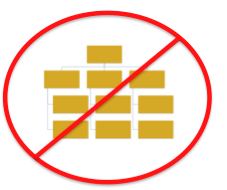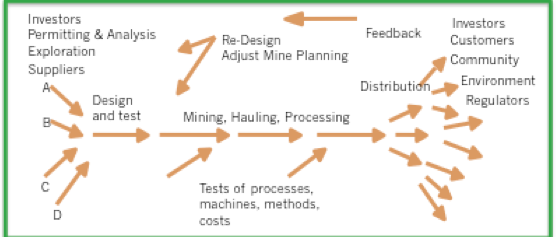 An unprecedented breakthrough in mining in the historical gold mining district of the Comstock in Nevada is happening through a systems-based approach to management. This post is by Travis Higgins, Director of Quality for Comstock Mining Inc. who is in charge of the implementation of the Decalogue Management Methodology within the company. Travis is an expert in the Critical Chain Project Management approach and a driving force for continuous improvement and breakthrough in this complex environment.
An unprecedented breakthrough in mining in the historical gold mining district of the Comstock in Nevada is happening through a systems-based approach to management. This post is by Travis Higgins, Director of Quality for Comstock Mining Inc. who is in charge of the implementation of the Decalogue Management Methodology within the company. Travis is an expert in the Critical Chain Project Management approach and a driving force for continuous improvement and breakthrough in this complex environment.
We are defined by our network of human and environmental interactions
Traditional mining companies are structured as a traditional hierarchy. A hierarchy, like the one pictured below, shows who is in charge of whom and how control is exercised throughout the organization.

Unfortunately, this picture is missing a few key elements. For one, this diagram does not answer the question, “Who is required to work together and in what ways?” In addition, “external” entities are completely absent from this picture, despite the fact that they are critical to the success of the company. We believe that many of our industry’s typical problems (e.g. cost overruns, delays in production, boom & bust expansion) are a result of ignoring or mismanaging these critical interdependencies. We don’t accept this norm nor are we satisfied to operate like a traditional mining company.
The picture above is a sketch of mining operations viewed as a system. It contains interdependencies, external entities, and a feedback loop driving improvement. Our company deploys this interconnected view of our operations in all that we do. Employee roles in our Company are not defined by who is their boss but instead by what processes they are involved in and how they interdepend with others. Additionally, our processes include a genuine integration of our community, politicians, regulators, suppliers, and customers. As a for-profit company with a long-term mindset, our goal is to generate sustainable wealth. We firmly believe that achieving “win-win” solutions for all stakeholders is not only possible but also necessary to achieve this goal. We reject any transaction that creates scarcity because this can only degrade our potential to sustain wealth creation.
Quality requires prediction
We believe quality is at the heart of any successful endeavor. Quality to us means predictable performance in all that we do. This requires not only delivering quality precious metal in a safe manner and reclaiming the land for productive use but also maintaining predictable, stable cash generation. Creating an organization that operates predictably requires an understanding of how variation affects our performance. Firstly, we strive to reduce “man-made” variation by reducing our reliance on tribal knowledge, verbal instructions and individual methods for completing routine activities. We document our system in an easily accessible “Playbook” (processes, interdependencies, work instructions) and train all employees on the agreed upon tactics. We fundamentally believe that, “If you can’t describe what you are doing as a process, you don’t know what you’re doing”. Next, to gain understanding about our processes, we must be able to filter out the noise of inherent variation and identify meaningful signals. Our Company uses rigorous statistical methods to distinguish between the two and enable the antithesis of fire fighting, the effective management of our Company.
We keep things flowing
Our primary business measurement is the speed at which we are able to generate cash and we call this Throughput. The first step to increasing our Throughput is to recognize that our production is a chain and thus is limited by its “weakest link”. We call this “link” our Constraint and we build our organization around it. We protect it from routine variation and synchronize the entire organization through finite-capacity scheduling. Synchronization, of even the most well-meaning and capable people, requires clear priorities that prevent wasting capacity on work that doesn’t increase Throughput. In order to achieve this synchronization, people must understand how they affect the Constraint and also be rewarded for their effective subordination to it. The next step to increasing our Throughput is by changing and improving the organization through project execution. Projects are by definition “non-routine” and require an enormous amount of synchronization. Project Management at our Company means reducing multitasking, buffering against uncertainties, and providing clear priorities for active task management.
Flourishing people do great things
A Company’s success depends on the involvement of its people. We seek out employees that fit our system and hire every one with respect, good pay, and a lot of responsibility. We value every individual and foster a working environment based on trust, constructive conflict, commitment, accountability and attention to results. Ultimately, we believe that sustained high involvement is the by-product of committed and competent employees. We expect our valued employees to remain highly committed if their work provides opportunities for mastery, autonomy, and a higher purpose. We are dedicated to improving and expanding our individual competencies and increasing our organizational knowledge. We believe this kind of continuous learning can only exist in a joyous atmosphere – so above all, we make mining fun.
See also our series on Systemic Management:
Why a Software Can Never Manage a Company
Transforming Industry with a Systemic Approach
Managing Projects the Systemic Way: Critical Chain
The Crucial Role of Synchronization in a Systems-Based Approach to Management
Operating a Systemic Organization: The Playbook
Managing a Systemic Organization: The Information System
The Physics of Management: Network Theory and Us
No Fear in the Workplace – Making It Happen
Drive Out Fear by Learning to Think Systemically
Don’t Climb, Grow! Success in the Systemic Organization
Can We Do Away with Hierarchy?
The Network of Projects: Driving Out Fear in the Post-Digital Age
Fear-free Career Paths in the Network of Projects
Learning, Joy, and the Interconnected Future
Structuring the Network of Projects: Algorithms and Emotions
Start Making Sense: Introduction To Statistical Process Control






Mr. Higgins neglected to cite W. Edwards Deming for the source of the schematic diagram in his blog: _Out of the Crisis_, p 4, MIT Center for Advanced Engineering (1982).